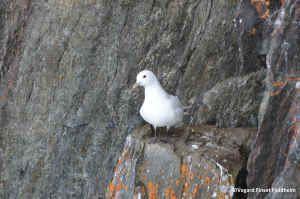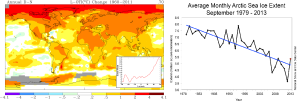About vegardf
View all posts by vegardf
The ivory gull, a high-Arctic specialist
by Vegard Finset Fjeldheim
The polar bear is by many regarded as the symbol of the Arctic. White and majestic, and very well adapted to its environment With Snowy Mountains and ice covered fjords. However, the polar bear is not the only animal that depends on the sea ice. The ivory gull is a high-Arctic seabird species, and the only bird associated with sea ice throughout the year [1, 2], It is pure white, with black legs and dark eyes, as shown in Figure 1 and 3 [3]. The ivory gull nest in colonies, sparsely distributed in the northern areas of Canada, Greenland, Norway (Svalbard) and western parts of Russia [1].It has a wide variety of food sources, primarily foraging on polar cod and crustaceans, but also human waste, carrions killed by polar bear and excrements and placenta etc. from marine animals [1]. Observations of the ivory gull, e. g. Inuit communities, indicated that the population was declining, and a study done by Canadian scientist showed a 80 % decline in numbers of nestling gulls in Arctic Canada [4]. What might be the reason for this declination, and do humans somehow contribute to it?
Figure 1. An ivory gull in a nestling colony at Spitsbergen, Svalbard.
It is believed that the ivory gull finds most of its pray close the the ice edge. By attaching small satellite transmitters to ivory gulls from Canadian islands, scientists has been able to monitor their movement during the year [5]. The monitored gulls rarely traveled over open waters free of ice, but tended to remain close to pack ice- and ice floe edges throughout the winter. The areas around Davis Strait and the Labrador Sea was found to important wintering areas for the ivory gull, most likely because these areas provide a predictable food supply along the pack ice edge. These areas are also found to be an important wintering destination for the nestling gulls in Svalbard and Russia [6]. The study also found that the individuals vary greatly in migration routs and timing, most likely due to the gulls affinity to the sea ice and their apparent avoidance of open water. The sea ice formation and extent in the fall vary from year to year, and the ivory gull will choose the migration route with the best foraging opportunities. With warmer temperatures, both in the ocean and atmosphere, the extent and timing of sea ice formation is changing and highly affecting the ivory gulls foraging opportunities, see Figure 2. Warmer ocean temperatures do not only have an impact on the sea ice, but might also alter the distribution of the gulls pray in the water masses [5].
(a) (b)
Figure 2. (a) show trends in the mean annual surface temperature from 1960-2011. The highest increase in temperature is found in the Arctic [11]. (b) show average monthly Arctic sea ice extent, with a blue trend line, in September, when the sea ice has its minimum extent [12].
The Arctic is not a clean area unaffected by human activity, but contaminants from the industrialized world is transported to the Arctic by various routes such as oceanic and atmospheric transport [7]. Here, the contaminants are easily incorporated in the Arctic ecosystems. Arctic animals can store large amount of fat for insulation and energy supply when food becomes sparsely [8]. Persistent organic pollutants (POPs) are one type of contaminants transported to the Arctic, and stored in the organism body fat when taken up in the biological system. Since the organisms have no efficient detoxification of such pollutants, it is stored and passed on to the next generation or next organism in the food chain if it is eaten. [2, 9], This means that animals situated high in the food chain may accumulate high levels of these contaminants. The ivory gull, that have polar cod and seal residues in its menu, have a high position in the Arctic food chain. To figure out the level of contaminants in ivory gulls, eggs collected from the Russian and Norwegian Arctic were analyzed [2]. They found that fat soluble organoclochlorines, including PCBs and DDE (a product from decomposition of DDT), dominated the contaminant profile, and the level was among the highest ever reported in Arctic seabirds. As noted in the article, the levels are lower than in eggs from birds of pray and gulls in the 1960s and 1970s in temperate areas when the use of these substances were not regulated, but local sources of emission in the Arctic are still relatively few. The effects of these pollutions are not very well known for the ivory gulls, but it is believed to have a negative long-term effect in the reproductive success. This is mainly based on other studies of seabirds at the top of the Arctic food chain that have shown reproductive, developmental, behavioral and immunological effects with even lover levels of contaminants than found in the ivory gull.
At The International Union for Conservation of Nature and Nature Resources’ (IUCN) Red List of Threatened species, the ivory gull is classified as near threatened with global warming and pollution as major threats [10]. And sadly, the gull is not itself responsible for these changes. It is believed that human activity has a large impact in the global warming we now are facing, and humans are for sure responsible for the pollutant found in ivory gulls and other species in the high-Arctic. On top of this, it is also believed that hunting of ivory gulls, mainly along the cost of Greenland, is a contributing factor to the declination, but the scope of this is not well known [1].
Figure 3. Will this be an even more rare sight in the future?
While we humans sit here in the «south» and live our normal lives, the price of this is paid among others by the ivory gulls and other high-Arctic animals. Our use of chemicals and increased emissions of climate gasses are effecting an changing the Arctic ecosystems and hence the habitat preferences of the ivory gull. How the ivory gull will deal with the declines of extent and duration of sea ice, and the consequences of this, is still not known, but the ivory gull is an ideal bioindicator of the effects of the global warming due to its proximity to the sea ice. To conclude, the ivory gull might be an Arctic climate refugee forced to flee by human activities.
References:
[1] Hallvard Strøm. Ismåken-en arktisk klimaflyktning? Vår Fuglefauna, 30:108–114, 2007.
[2] C. Miljeteig, H. Strøm, M. V. Gavrilo, A. Volkov, B. M. Jenssen, and G. W. Gabrielsen. High levels of contaminants in ivory gull Pagophila eburnea eggs from the russian and norwegian arctic. Enviromental Science & Technology, 40(14):5521–5529, 2009.
[3] Hallvard Strøm. Svalbards fugler. In K. M. Kovacs and C. Lydersen, editors, Svalbards fugler og pattedyr, pages 151–154.Norsk Polarinstitutt, polarhåndbok, 13 edition, 2006.
[4] H. G. Gilchrist and M. L.Mallory. Declines in abundance and distribution of the ivory gull (Pagophila eburnea) in arctic canada. Biological Conservation, 121:303–309, 2005.
[5] N. C. Spencer, H. G. Gilchrist, and M. L.Mallory. Annual movement patterns of endangered ivory gulls: The importance of sea ice. PLoS ONE, 9(12), 2014. doi:10.1371/journal.pone.0115231.
[6] O. Gilg, H. Strøm, A. Aebischer, M. V. Gavrilo, A. E. Volkov, C. Miljeteig, and B. Sabard. Post-breeding movements of northeast atlantic ivory gull Pagophila eburnea populations. Journal of Avian Biology, 41:532–542, 2010. doi:19.1111/j.1600-048x.2010.05125.x.
[7] I. C. Burkow and R. Kallenborn. Sources and transport of persistent pollutants to the arctic. Toxicol. Lett., 112:87–92, 2000.
[8] Pål Prestrud. Adaptions by the arctic fox (Alopex lagopus) to the polar winter. Arctic, 44(2):132–138, 1991.
[9] Samuel C. Byrne. Persistent organic pollutians in the Arctic. A Report for the Delegates of the 4th Conference of the Parties Stockholm Convention on Persistent Organic Pollutants, 2009
[10] The IUCN Red List of Threatened Species. Pagophila eburnea. Version 3, 2014. <www.iucnredlist.org>. Downloaded on 19 February 2015.
[11] National Snow & Ice Data Center. Climate Change in the Arctic <https://nsidc.org/cryosphere/arctic-meteorology/climate_change.html> Downloaded on 19 February 2015.
[12] National Snow & Ice Data Center. Poles apart: A record-breaking summer and winter <http://nsidc.org/arcticseaicenews/2012/10/poles-apart-a-record-breaking-summer-and-winter/> Downloaded 19 February 2015.


